小学英语优质课教案
小学英语《Unit 1 Shes a nice teacher》优质课教学设计、教案
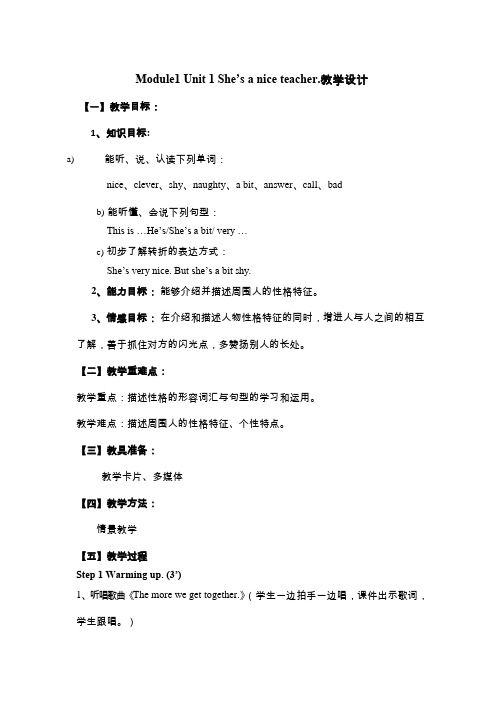
Module1 Unit 1 She’s a nice teacher.教学设计【一】教学目标:1、知识目标:a)能听、说、认读下列单词:nice、clever、shy、naughty、a bit、answer、call、badb)能听懂、会说下列句型:This is …He’s/She’s a bit/ very …c)初步了解转折的表达方式:She’s very nice. But she’s a bit shy.2、能力目标:能够介绍并描述周围人的性格特征。
3、情感目标:在介绍和描述人物性格特征的同时,增进人与人之间的相互了解,善于抓住对方的闪光点,多赞扬别人的长处。
【二】教学重难点:教学重点:描述性格的形容词汇与句型的学习和运用。
教学难点:描述周围人的性格特征、个性特点。
【三】教具准备:教学卡片、多媒体【四】教学方法:情景教学【五】教学过程Step 1 Warming up. (3’)1、听唱歌曲《The more we get together.》(学生一边拍手一边唱,课件出示歌词,学生跟唱。
)【设计意图】:通过师生齐唱唱英文歌,拉近师生的距离,渲染课堂气氛。
并进一步引出本模块的话题:朋友。
T: This is a song about friends. Today, we will talk about our friends.Step 2:Presentation(4’)1、T: Boys and girls. look ,(出示幻灯片)These are my friends. This is MeiYangyang. She’s very nice.出示单词nice。
板书:nice 采用先读rice 再读nice 的方法学习单词,教师领读该句型,出示害羞的动画引出句型Butshe’s a bit shy.教师板书a bit 和shy,领读单词及句型。
并告诉学生:本节课我们学习如何描述人物的性格,然后我们能够介绍自己的朋友。
小学英语《Can I have some sweets》课教学设计、教案

小学英语《Can I have some sweets》优质课教学设计、教案一、教学背景分析1.1 教材分析本课选取自人教版小学英语PEP教材,针对三年级学生设计。
本课内容为故事课,主要讲述了一个关于孩子们要求吃糖果的情境,通过这个故事,让学生学会使用情态动词"Can"提出请求,并能用"Yes, he can./No, he can't."回答。
1.2 学情分析三年级学生具备一定的基础英语词汇和语法知识,对学习英语有浓厚的兴趣。
但部分学生可能在发音和口语表达上存在困难,需要重点关注和指导。
二、教学目标2.1 知识目标学生能够听懂、会说、会读故事中的主要词汇和句子,如"Can I have some sweets?"和"Yes, he can./No, he can't."。
2.2 能力目标学生能够在情境中正确使用情态动词"Can"提出请求,并回答相应的问题。
2.3 情感目标培养学生乐于助人的品质,教育学生注意饮食健康。
三、教学重点与难点3.1 教学重点学生能够掌握故事中的主要词汇和句子,并在实际情境中运用。
3.2 教学难点学生能够正确使用情态动词"Can"提出请求和回答问题。
四、教学方法4.1 情境教学法:通过设置故事情境,让学生在实际语境中学习词汇和句子。
4.2 交际教学法:引导学生进行角色扮演,提高口语表达能力。
4.3 游戏教学法:通过趣味游戏,激发学生的学习兴趣,巩固所学知识。
五、教学过程5.1 热身(5分钟)教师与学生进行简单的英语对话,检查学生的英语水平,为学生进入学习状态做好准备。
5.2 引入(10分钟)教师展示故事中的图片,引导学生预测故事内容。
播放故事录音,让学生初步感知故事情节。
5.3 学习(20分钟)教师带领学生学习故事中的主要词汇和句子,如"Can I have some sweets?"和"Yes, he can./No, he can't."。
小学英语《My friends》优质课教学设计、教案

小学英语《My friends》优质课教学设计、教案1.教学目标- 学生能够通过研究《My friends》这首歌曲,掌握一些简单的英语表达方式,如询问和回答关于朋友的问题。
- 学生能够积极参与课堂活动,展示他们对于朋友的理解,并能够用英语进行简单交流。
2.教学准备- 《My friends》歌曲的录音或视频资源- 学生用纸和彩色笔- 图片或卡片,上面写有不同的朋友形象(男孩、女孩、动物等)3.教学过程步骤一:引入歌曲(5分钟)- 播放《My friends》歌曲的录音或视频。
- 学生先只是听,不要求他们理解歌词内容,只需要感受歌曲的节奏和旋律。
步骤二:理解歌词(10分钟)- 给学生发放歌曲的歌词,让他们尝试阅读。
- 分段展示歌词,帮助学生理解词语的意思。
- 逐句解释歌词中一些重要的词汇,如“friend”、“hello”、“goodbye”等。
步骤三:学唱歌曲(15分钟)- 分段教学并示范歌词的发音和语调。
- 按照节奏和旋律,带领学生一起唱歌。
- 反复练直到学生能够熟练地唱出整首歌曲。
步骤四:研究朋友的表达方式(15分钟)- 准备不同的朋友形象的图片或卡片,如男孩、女孩、动物等。
- 指着图片或卡片,教学学生用英语表达不同的朋友形象,如“What's his name?”和“His name is Tom.”。
- 练问问题和回答的对话,鼓励学生互相练。
步骤五:创作自己的朋友(20分钟)- 要求学生用纸和彩色笔,画出一个自己想象中的朋友形象。
- 引导学生使用英语描述自己所画的朋友形象,如“What's your friend like?”和“She is kind and funny.”。
4.教学延伸- 让学生分组进行角色扮演,通过对话的方式表达自己的朋友形象。
- 鼓励学生找来自己的照片,用英语介绍自己的朋友。
5.总结- 回顾学生在这堂课上学到的朋友的表达方式和自我表达的能力。
- 强调学生研究英语不仅是为了研究知识,更是为了能够用英语与他人进行交流。
小学英语《Animals》优质课教学设计、教案

小学英语《Animals》优质课教学设计、教案一、教学目标1. 研究并掌握动物的英语名称。
2. 能够运用所学内容进行简单的问答交流。
3. 培养学生对动物的兴趣,并提高他们的口语表达能力。
二、教学内容1. 基本词汇:猫、狗、鸟、鱼、熊、兔子等。
2. 句型表达:What animal is this? / It is a ______. / Do you like ______? / Yes, I do. / No, I don't.三、教学过程1. 导入新课- 利用图片或实物引入不同的动物,并出示幻灯片以展示动物的英语名称。
2. 研究新词汇- 教师通过情境演示、讲解和示范,引导学生逐个研究新的动物词汇。
3. 句型研究- 教师示范并引导学生模仿,使用句型进行简单的问答交流。
4. 合作活动- 学生分组,每组选择一种动物,利用所学句型进行问答,展示给全班。
5. 温故知新- 教师复以前学过的部分动物名称,并进行回顾、检查。
6. 游戏活动- 教师设计相关游戏活动,激发学生的研究兴趣,并加强对词汇和句型的记忆和运用。
7. 练与巩固- 学生在教师的引导下,进行练和巩固,如简单的问答、填空练等。
8. 总结与反思- 教师引导学生总结当堂课研究的内容,并帮助学生进行反思和提出问题。
四、教学评价- 教师通过观察学生的研究情况、参与度和表现,进行评价和记录。
五、拓展延伸- 学生可自行查找与动物相关的英语材料,进行个人或小组的延伸研究。
六、教学资源- 图片或实物- 幻灯片- 游戏道具等以上是小学英语《Animals》优质课教学设计、教案的初步内容,供参考。
小学英语教案(优秀3篇)
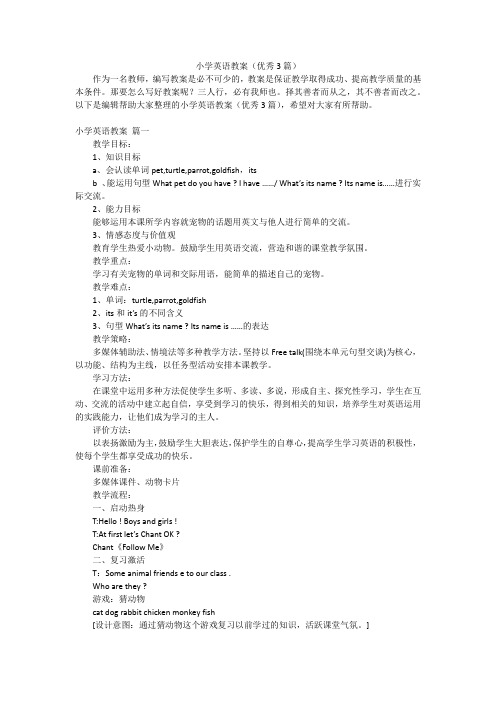
小学英语教案(优秀3篇)作为一名教师,编写教案是必不可少的,教案是保证教学取得成功、提高教学质量的基本条件。
那要怎么写好教案呢?三人行,必有我师也。
择其善者而从之,其不善者而改之。
以下是编辑帮助大家整理的小学英语教案(优秀3篇),希望对大家有所帮助。
小学英语教案篇一教学目标:1、知识目标a、会认读单词pet,turtle,parrot,goldfish,itsb 、能运用句型What pet do you have ? I have ……/ What’s its name ? Its name is……进行实际交流。
2、能力目标能够运用本课所学内容就宠物的话题用英文与他人进行简单的交流。
3、情感态度与价值观教育学生热爱小动物。
鼓励学生用英语交流,营造和谐的课堂教学氛围。
教学重点:学习有关宠物的单词和交际用语,能简单的描述自己的宠物。
教学难点:1、单词:turtle,parrot,goldfish2、its和it’s的不同含义3、句型What’s its name ? Its name is ……的表达教学策略:多媒体辅助法、情境法等多种教学方法。
坚持以Free talk(围绕本单元句型交谈)为核心,以功能、结构为主线,以任务型活动安排本课教学。
学习方法:在课堂中运用多种方法促使学生多听、多读、多说,形成自主、探究性学习,学生在互动、交流的活动中建立起自信,享受到学习的快乐,得到相关的知识,培养学生对英语运用的实践能力,让他们成为学习的主人。
评价方法:以表扬激励为主,鼓励学生大胆表达,保护学生的自尊心,提高学生学习英语的积极性,使每个学生都享受成功的快乐。
课前准备:多媒体课件、动物卡片教学流程:一、启动热身T:Hello ! Boys and girls !T:At first let’s Chant OK ?Chant《Follow Me》二、复习激活T:Some animal friends e to our class .Who are they ?游戏:猜动物cat dog rabbit chicken monkey fish[设计意图:通过猜动物这个游戏复习以前学过的知识,活跃课堂气氛。
小学英语优质教案幼儿园
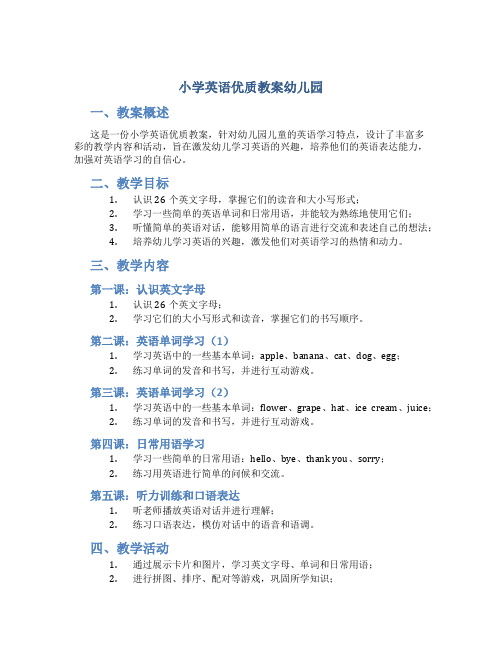
小学英语优质教案幼儿园一、教案概述这是一份小学英语优质教案,针对幼儿园儿童的英语学习特点,设计了丰富多彩的教学内容和活动,旨在激发幼儿学习英语的兴趣,培养他们的英语表达能力,加强对英语学习的自信心。
二、教学目标1.认识26个英文字母,掌握它们的读音和大小写形式;2.学习一些简单的英语单词和日常用语,并能较为熟练地使用它们;3.听懂简单的英语对话,能够用简单的语言进行交流和表述自己的想法;4.培养幼儿学习英语的兴趣,激发他们对英语学习的热情和动力。
三、教学内容第一课:认识英文字母1.认识26个英文字母;2.学习它们的大小写形式和读音,掌握它们的书写顺序。
第二课:英语单词学习(1)1.学习英语中的一些基本单词:apple、banana、cat、dog、egg;2.练习单词的发音和书写,并进行互动游戏。
第三课:英语单词学习(2)1.学习英语中的一些基本单词:flower、grape、hat、ice cream、juice;2.练习单词的发音和书写,并进行互动游戏。
第四课:日常用语学习1.学习一些简单的日常用语:hello、bye、thank you、sorry;2.练习用英语进行简单的问候和交流。
第五课:听力训练和口语表达1.听老师播放英语对话并进行理解;2.练习口语表达,模仿对话中的语音和语调。
四、教学活动1.通过展示卡片和图片,学习英文字母、单词和日常用语;2.进行拼图、排序、配对等游戏,巩固所学知识;3.唱歌、跳舞、表演等活动,帮助幼儿记忆单词和短语;4.组织互动游戏和小组活动,提高幼儿英语的口语表达能力。
五、教学评估通过观察和试听幼儿的表现,以及平时的作业完成情况、小组活动表现、口语发音等方式进行评估。
六、教学方法1.善于运用多种教学方法,如情景教学法、游戏教学法、音乐教学法等,使幼儿更加主动参与到英语学习中;2.采用多种教学手段,如图片、卡片、视频、音频等辅助教学。
七、教学效果通过这份小学英语优质教案的实施,幼儿在英语学习方面取得了很好的进步,达到了预期的教学目标。
小学英语《You can play football well》优质课教学设计、教案

小学英语《You can play football well》优质课教学设计、教案Step 1.Warm-up1.XXX.2.XXX elementary school students。
setting up a footballteam according to the content of this lesson。
and cultivating students' n awareness。
n spirit。
XXX.3.XXX flashing picturesXXX' usly learned verb phrases。
and using the courseware to review phrases: "" and "Look and say with ns."4.Making full use of pictures to introduce "I can。
" and switching to the second person to say "You can。
" XXX.5.XXX the us "Can you。
" sentence structure and its answers。
XXX.Step 2.1.Watching a video of people playing basketball。
and asking students if they can play basketball.2.XXX.During the video。
students watch with sity and ns。
perceiving and understanding the text as a whole。
The video captures their n and helps them learn the key language points of the lesson.XXX recording。
小学英语《Family》优质课教学设计、教案
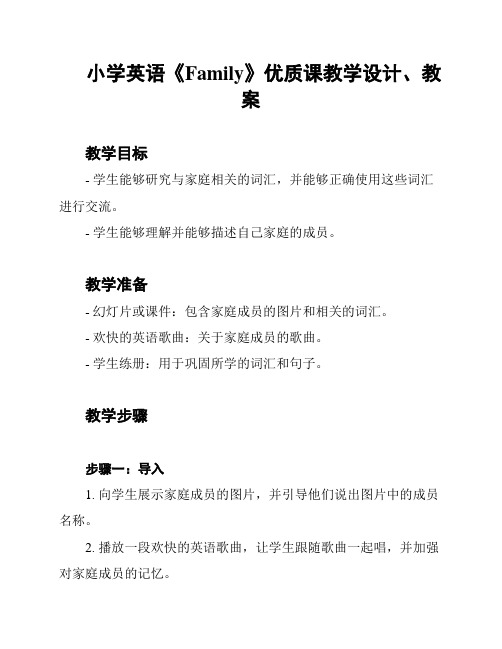
小学英语《Family》优质课教学设计、教案教学目标- 学生能够研究与家庭相关的词汇,并能够正确使用这些词汇进行交流。
- 学生能够理解并能够描述自己家庭的成员。
教学准备- 幻灯片或课件:包含家庭成员的图片和相关的词汇。
- 欢快的英语歌曲:关于家庭成员的歌曲。
- 学生练册:用于巩固所学的词汇和句子。
教学步骤步骤一:导入1. 向学生展示家庭成员的图片,并引导他们说出图片中的成员名称。
2. 播放一段欢快的英语歌曲,让学生跟随歌曲一起唱,并加强对家庭成员的记忆。
步骤二:词汇研究1. 通过幻灯片或课件,向学生展示不同家庭成员的图片,并教授相关的英文词汇。
2. 让学生跟随教师一起朗读词汇,并进行反复的练,以巩固词汇记忆。
步骤三:交流练1. 学生之间进行小组交流,描述自己的家庭成员。
教师可提供一些问题作为引导,如"Who is in your family?"、"What does your father/mother/sister/brother do?"等。
2. 鼓励学生用学过的词汇和句子回答问题,并帮助他们改正语法错误和发音问题。
步骤四:拓展活动1. 让学生分角色扮演不同的家庭成员,并进行对话练。
教师可提供一些对话的模版,并鼓励学生进行创新。
2. 学生之间进行对话表演,并互相评价对方的表现,以促进互动和合作。
教学评价- 教师观察学生的参与情况和口语表达能力。
- 学生之间进行互相评价和反馈,鼓励他们提供积极的建议和改进意见。
- 教师检查学生完成的练册,评估他们的词汇和句子应用能力。
参考资料- 小学英语课程教材- 英语歌曲资源。
小学英语《let's spell》优质课教学设计、教案
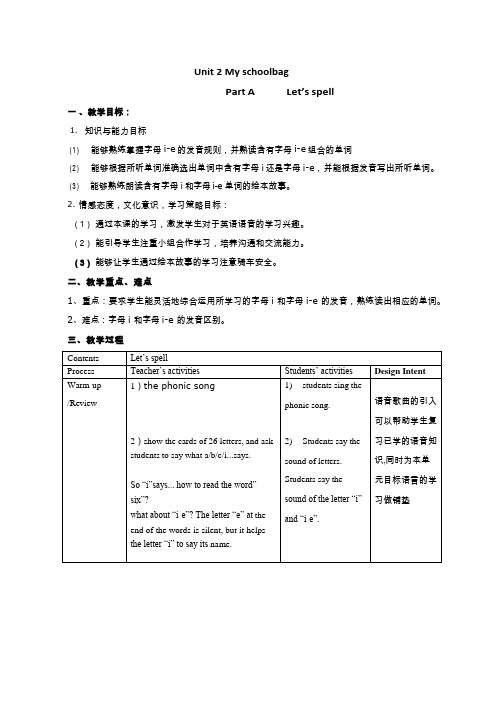
一、教学目标:
1.知识与能力目标Unit 2 My schoolbag
Part A Let’s spell
(1)能够熟练掌握字母i-e 的发音规则,并熟读含有字母i-e 组合的单词
(2)能够根据所听单词准确选出单词中含有字母i 还是字母i-e,并能根据发音写出所听单词。
(3)能够熟练朗读含有字母 i 和字母 i-e 单词的绘本故事。
2.情感态度,文化意识,学习策略目标:
(1)通过本课的学习,激发学生对于英语语音的学习兴趣。
(2)能引导学生注重小组合作学习,培养沟通和交流能力。
(3)能够让学生通过绘本故事的学习注意骑车安全。
二、教学重点、难点
1、重点:要求学生能灵活地综合运用所学习的字母i 和字母i-e 的发音,熟练读出相应的单词。
2、难点:字母i 和字母i-e 的发音区别。
三、教学过程
Board Design
Unit 2 My schoolbag
the phonics park
i i-e
big dig six kite like rice five nine。
全国小学英语优质课竞赛一等奖教案
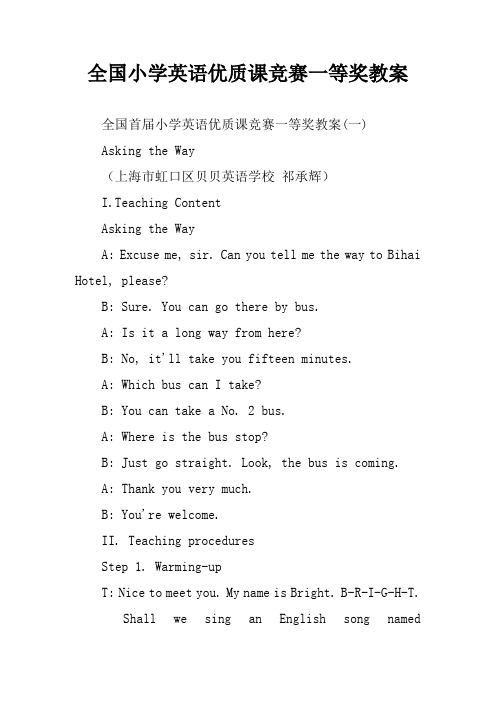
全国小学英语优质课竞赛一等奖教案全国首届小学英语优质课竞赛一等奖教案(一)Asking the Way(上海市虹口区贝贝英语学校祁承辉)I.Teaching ContentAsking the WayA: Excuse me, sir. Can you tell me the way to Bihai Hotel, please?B: Sure. You can go there by bus.A: Is it a long way from here?B: No, it'll take you fifteen minutes.A: Which bus can I take?B: You can take a No. 2 bus.A: Where is the bus stop?B: Just go straight. Look, the bus is coming.A: Thank you very much.B: You're welcome.II. Teaching proceduresStep 1. Warming-upT: Nice to meet you. My name is Bright. B-R-I-G-H-T.Shall we sing an English song named"Bingo", and try to change the' word "Bingo" with my name "Bright"?Step 2. PresentationT: I'm new here, when I arrived at the airport, I heard someone said "对不起"(注①),"早晨好"(注②).I really want to know their meanings in English. Could you help me?S: "对不起" is "Excuse me" and "早晨好" is "Good morning".T: Thanks a lot. And now could you tell me something about your city? I want to travel in this city, but I don't know where I should go.S1: Bai Lian Dong Park.S2: Fisher Girl.S3: Jiuzhou Town.T: Good. But I want to find a hotel now.Please do me a favour. Can you tell me the names of some hotels in this city?S1: XX Hotel.S2: Yindu Hotel.S3: Bihai Hotel.(The teacher takes notes while the students arespeaking.)Step 3. New structures learningT: They all sound very nice. But how can I get there, by bus or by bike?S: By bus.T: And how long will it take me to get there? Maybe fifteen minutes is enough.(The teacher looks at the watch and gives the students a gesture.)1) Draw a stick-figure picture to help the students understand the meaning ofthe sentence:"It'll take someone some time to do something."2) Write the sentence "It'll take you fifteen minutes. " on the blackboard, andhave the students imitate the sentence.3) A guessing game:T: Please look at these pictures and guess "How long will it take me to ...?"T: How long will it take me to have a football match?S1: It'll take you ninety minutes.T: Yes.4) Get the students to listen to the recording of the dialogue, in order tointroduce the new sentence: "Just go straight."5) Use the multi-media to help the students understand the meaning of thesentence "Go straight."6) Write the sentence on the blackboard, and have the students imitate thesentence: "Just go straight."Step 4. Practice1) Ask the students to listen to the dialogue once more, then ask them to repeatafter the tape, first individually and then in pairs.2) Encourage the students to read their dialogue with their deskmates.Step 5. ConsolidationT: You know I'm from Shanghai. Maybe in the future you'll go to Shanghai, soI've prepared some photographs for you.1) Show the photographs of "Nanjing Road", "udong New Area" and "the Bund" to the students.2) Get the students to ask the teachers from Shanghai something they don'tknow, such as directions, transportations in Shanghai.3) Ask some students to introduce their tour plans to Shanghai.注①、注②:因竞赛在珠海举行,授课教师用广东话说“对不起”和“早晨好”。
小学英语《What can you do》优质课教学设计、教案
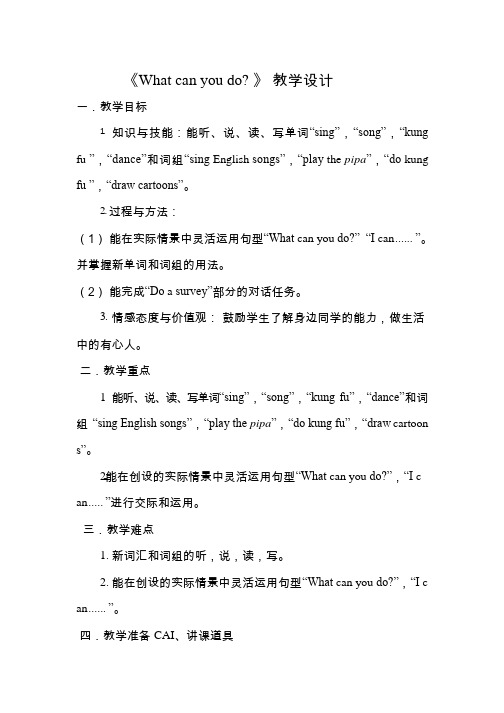
《What can you do? 》教学设计一.教学目标1.知识与技能:能听、说、读、写单词“sing”,“song”,“kung fu ”,“dance”和词组“sing English songs”,“play the pipa”,“do kung fu ”,“draw cartoons”。
2.过程与方法:(1)能在实际情景中灵活运用句型“What can you do?”“I can ...... ”。
并掌握新单词和词组的用法。
(2)能完成“Do a survey”部分的对话任务。
3.情感态度与价值观:鼓励学生了解身边同学的能力,做生活中的有心人。
二.教学重点1.能听、说、读、写单词“sing”,“song”,“kung fu”,“dance”和词组“sing English songs”,“play the pipa”,“do kung fu”,“draw cartoon s”。
2...能在创设的实际情景中灵活运用句型“What can you do?”,“I c an ..... ”进行交际和运用。
三.教学难点1.新词汇和词组的听,说,读,写。
2.能在创设的实际情景中灵活运用句型“What can you do?”,“I c an ...... ”。
四.教学准备CAI、讲课道具五.教学过程Step1 .Warm-up and lead-in(1)Greetings: Hello,boys and girls. Are you ready? OK, please give me a big smile.(2)Let’s doT:Look, what’s the weather like today? It’s cold, so let’s do, OK! Follow me, stand up , shake your body, clap your hands, sit down please!T:You see, I can stand up, I can clap hands, I can shake body, I can clap hands. I can do many things. I am wonderful. Now I let’s watch a video and try to answer “ What can Miss wu do in the video?”,请学生一起观看视频,通过视频找到答案,让学生初步整体感知本节课所教授的新知。
小学英语优质教案详案
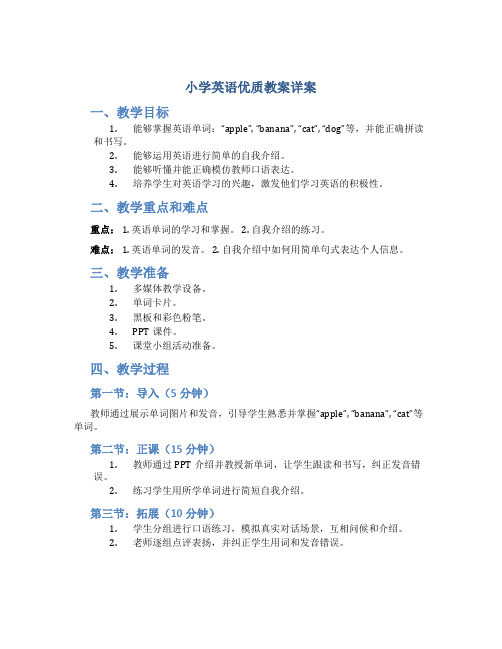
小学英语优质教案详案一、教学目标1.能够掌握英语单词:“apple”, “banana”, “cat”, “dog”等,并能正确拼读和书写。
2.能够运用英语进行简单的自我介绍。
3.能够听懂并能正确模仿教师口语表达。
4.培养学生对英语学习的兴趣,激发他们学习英语的积极性。
二、教学重点和难点重点: 1. 英语单词的学习和掌握。
2. 自我介绍的练习。
难点: 1. 英语单词的发音。
2. 自我介绍中如何用简单句式表达个人信息。
三、教学准备1.多媒体教学设备。
2.单词卡片。
3.黑板和彩色粉笔。
4.PPT课件。
5.课堂小组活动准备。
四、教学过程第一节:导入(5分钟)教师通过展示单词图片和发音,引导学生熟悉并掌握“apple”, “banana”, “cat”等单词。
第二节:正课(15分钟)1.教师通过PPT介绍并教授新单词,让学生跟读和书写,纠正发音错误。
2.练习学生用所学单词进行简短自我介绍。
第三节:拓展(10分钟)1.学生分组进行口语练习,模拟真实对话场景,互相问候和介绍。
2.老师逐组点评表扬,并纠正学生用词和发音错误。
第四节:总结(5分钟)老师和学生共同总结当天学习内容,并展望下节课内容。
五、板书设计英语单词英文发音中文意思apple /ˈæpəl/ 苹果banana /bəˈnɑːnə/香蕉cat /kæt/ 猫dog /dɔːɡ/狗六、教学反思通过本节课的教学,发现学生对于单词发音的掌握仍有待加强,下次课可加入更多发音练习。
同时,学生在自我介绍中表达较为生涩,需要进一步练习句型和流利度。
打算增加更多口语练习时间,提高学生的英语口语表达能力。
以上是本次小学英语优质教案详案,希望对教学工作有所帮助。
小学英语《Food》优质课教学设计、教案

小学英语《Food》优质课教学设计、教案一、教学目标- 通过本课的研究,使学生能够认识和掌握主要的食物词汇,如水果、蔬菜、肉类等;- 学会用英语描述不同种类的食物、味道和喜好;- 培养学生的口语交流能力,能够用英语讨论食物和饮食惯的问题。
二、教学内容1. 词汇- 水果:apple, banana, orange, strawberry等;- 蔬菜:carrot, tomato, broccoli, potato等;- 肉类:chicken, beef, pork等。
2. 句型- What's your favorite food? - My favorite food is...- Do you like...? - Yes, I do. / No, I don't.- How does it taste? - It tastes... (sweet, sour, etc.)3. 对话- 对话一:询问他人喜欢的食物和回答自己喜欢的食物;- 对话二:询问他人对某种食物的口味感受和回答自己对某种食物的口味感受。
三、教学步骤1. 导入新课:通过展示一些食物图片,引发学生对食物的兴趣,激活他们的背景知识。
2. 研究新词汇:呈现水果、蔬菜、肉类等词汇的图片和单词,让学生大声跟读,并和老师一起复和巩固。
3. 研究句型:教授"What's your favorite food?"这个句型,引导学生进行问答练,并扩展到"Do you like...?"和"How does it taste?"的问答上。
4. 角色扮演活动:学生分角色进行对话练,模拟真实场景,提高口语表达能力。
5. 小组讨论:把学生分为小组,每个小组讨论一种食物的口味感受,然后选取一个代表进行汇报。
6. 制作课堂展示:在教室里布置一个食物展示区,让学生用图片、图表等展示他们最喜欢的食物和口味感受,并用英语进行描述。
小学英语《My school》优质课教学设计、教案
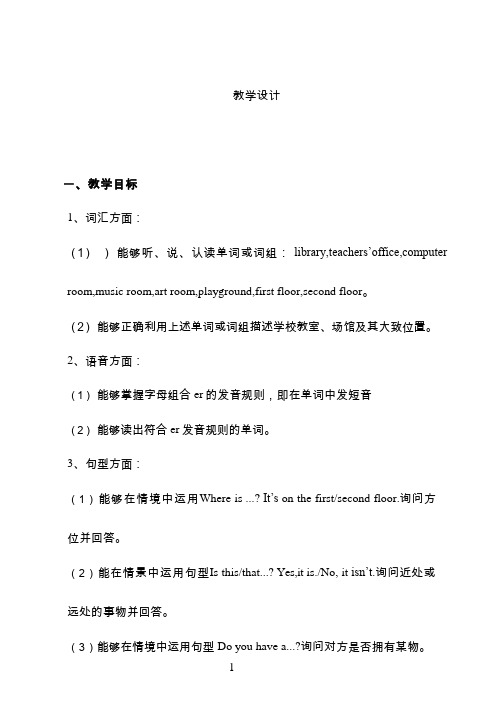
教学设计一、教学目标1、词汇方面:(1))能够听、说、认读单词或词组:library,teachers’office,computer room,music room,art room,playground,first floor,second floor。
(2)能够正确利用上述单词或词组描述学校教室、场馆及其大致位置。
2、语音方面:(1)能够掌握字母组合er 的发音规则,即在单词中发短音(2)能够读出符合er 发音规则的单词。
3、句型方面:(1)能够在情境中运用Where is ...? It’s on the first/second floor.询问方位并回答。
(2)能在情景中运用句型Is this/that...? Yes,it is./No, it isn’t.询问近处或远处的事物并回答。
(3)能够在情境中运用句型Do you have a...?询问对方是否拥有某物。
4、情感态度方面:(1)在生活中能主动提问,并对别人的询问能热情回答。
(2)了解学校教室、场馆的名称及位置,感受到学校的漂亮与温馨,从而激发对学校的热爱。
二、教学准备:课件,课前分组,给学生用的学校及图片,板书用的学校图片三、教学过程:1.W arm-up(1)Let’s sing a song《My school》(设计意图:歌曲导入,学生跟唱,活跃气氛。
同时引出课题。
)(2)Free talkThere are many teachers come to our school. What should we say ?(设计意图:通过向来学习的老师打招呼,既运用了英语中简单的问候语,又复习了Welcome to our school.同时为引出Peter 做铺垫。
通过Peter 来学校参观,他需要一个导游,设置了一系列任务。
)2.PresentationTask1.Brain storm.(1)T:We know there are many rooms or places in the school. Just like music room. Can you say more?S:...(2)T:Look at the pictures, Let’s say together.(3)T:Let’s say them quickly.(设计意图:头脑风暴,通过举例music room 让学生大脑迅速运转,回忆我们本单元学过的有关学校教室及场所的单词,然后我通过词卡和学生一起复习巩固,最后让学生快速读出单词,达到复习巩固的目的。
全国首届小学英语优质课竞赛一等奖教案

全国首届小学英语优质课竞赛一等奖教案 (三)A Telephone Call (广州珠海香洲区吉莲小学鲍当洪)I.Teaching MaterialA Telephone CallA: May I speak to Jim, please?B: Sorry. He's not at home.A: Where is he now?B: He went to the bookshop.A: Would you please take a message?B: Sure.A: Tomorrow is Teachers' Day. We'll have a party at school.B: What time is the party?A: At three thirty in the afternoon.B: OK, I'll tell him When he's back.A: Thank you.II. Teaching Aims1) Enable the students to make telephone calls in English andget them to know how to behave themselves on the telephone.2) Raise the students' interest to learn English.3) Encourage the students to have good cooperation with one another.III.Teaching contents1 ) Patterns:May I speak to ...?Would you please take a message?2) V ocabulary: message, party, take a messageIV.teaching AidsFour toy telephones, a CD-ROM, a toy Santa Claus.V. Teaching proceduresStep 1. Warming-up ExerciseSing the song "Greetings".Step 2. Presentation and Practice1) Ask the students to look at the screen and listen to the talk between theteacher and the person in the screen.2) After the talk, the teacher tells the students how to make a telephone call in English. Write the pattern "May I speak to...?"on the blackboard and teach them how t o use it on the phone.3) Using the four toy telephones, ask the students to make telephone calls inpairs with the following patterns:---- May I speak to...?---- Speaking.Those students who do not have toy telephones can use their pencil-boxesinstead, or they can put their fingers to their ears as a sign to make phone calls.4) Ask one student his/her name and his/her home telephone number, using the following sentences:Would you please 'tell me your name?Would you please tell me your home telephone number?5) Make a telephone call to a student and get the students to learn the following short dialogue:T: Hello. Is that 8614761?S: Yes.T: May I speak to Xiao Long?S: Sorry, he is not in the office.T: Would you please take a message and ask him to come to school this afternoon?S: Sure.T: Thank you.6) Ask the students to make calls in groups.Then ask some pairs to act out to see if they know how to use the patterns below: May I speak to..,?Would you please take a message?7) Ask the students to look at the screen and listen to the dialogue "A Telephone Call" withthe following questions in mind:What is the message about?What time is the party?Then ask the students some questions if they have understoodthe dialogue.8) Ask the students to look at the dialogue on the screen and listen to it again.9) The teacher tells the students the meaning of the word "tomorrow" with thehelp of a calendar and the following sentences:We'll have a party at school.I'll tell him when he's back.10) Ask the students to read the new word and the sentences on the blackboard.11) Ask the students to retell the dialogue in their own words in pairs.12) Play the game "Throwing Santa Claus" to see if the students can say the sentences well.The teacher throws the toy Santa Claus to a student. When the student catchesthe Santa Claus, he or she must say one of the sentences on the blackboard, and then t hrows the Santa Claus to another student.13) Ask the students to act out the dialogue in roles.Step 3.1) Show the students three pictures on the screen. Ask them tomake telephone calls in groups based on the picture they have chosen.Picture One: You want to invite Tom to play footbaU with you, butTom hasn't got a tel ephone at home. You ask Rose to take a message to Tom.Picture Two: Miss Wu is ill. You want to pay a visit to her with Jack. But Jack is not atme. His sister picks up thephone.Picture Three: You will hold a birthday party on Sunday. Youphone to Lily to invite her to your party, but she isn't at home. How do youspeak to her mother, who is at home at that time?2) Ask some pairs to act out their telephone calls.3) Ask the students to make phone calls to the teachers who are sitting aroundthe dassroom.The teacher tells the students:"There will be a party on New Year's Day. We will invit e some teachers to come to our party.Write the names and the telephone numbers of some teachers and maketelephone calls to them".Step 4. SummaryTell the students the way of making a phone call in their daily life.Step 5. HomeworkAsk the students to make phone calls to their friends and tell them their schoollife after class.Step 6: EndingSing the song "Happy Weekend".专家点评鲍当洪老师执教的 A Telephone Call是一节真实、自然、生动、有趣的小学英语课。
人教版小学英语全英教案

人教版小学英语全英教案【篇一:小学英语优秀教学设计】小学英语优秀教学设计(一)小学英语第五册(外研版)module 8 schoolunit 1 what time does school start?蓬莱市南王中心小学包晓晴一、教材分析module 8 book 5 的主题是“school”,“ unit 1 what time does school start?”的语言功能是描述学校生活;学习任务为“what time does school start? what time do you get up?”二、学情分析本课的教学对象是五年级学生,他们已经掌握了一定的英语词汇,具有一定的英语学习的积极性与主动性,具备了一定的英语语言运用能力,求知欲增强。
因此,在新知识传授的同时,教师要尽可能多的为学生创造良好的语言环境,给学生充足的语言“习得”机会,让学生在学习中积极参与、大胆发言,从而形成积极的情感态度和自主学习的能力。
三、教学目标(一)知识目标1、能听懂、会说并认读下列单词:exercise, before, playground, skip, coffee, tea.2、能听懂、会说并认读下列句子:what time does school start? my school starts at 9 o?clock. what time do you get up? i get up at half past seven.(二)能力目标能口头运用“what time does school start?”这类语句询问发生的时间,并能口头运用“my school starts at 9 o?clock.”这类语句回答。
(三)情感目标为学生创设轻松、愉悦、和谐的英语课堂学习氛围,使学生在学习中敢于开口说英语,并了解西方小学学校日常生活习惯,从而对英语学习产生更为浓厚的兴趣。
四、教学要点分析(一)教学重点1.单词:exercise, before, playground, skip, coffee, tea 的认读。
小学英语《Thereisabigbed》优质课教学设计、教案

教学设计一、教学内容 (Teaching contents )NeW Sentences( 新句型):There is a … in my room.New phrases( 新单词 ):photo二、教学目标 (Teaching aims and demands )(一)认知目标 (KnoWledge Aims)1 、Words --- 能听、说、认读本课时的主要单词: photo2 、Sentences--- 能听说、认读本课时的主要句型 There is a …in my room. 并在实际情境中灵活运用句型描述自己的房间里有哪些物品。
(二)能力目标 (Skill Aims)1、能够按照正确的语音语调,按照正确的意群朗读课文,并且能够进行角色扮演。
2、能够运用本课时重点句型描述自己的房间里有哪些物品。
(三)文化、情感目标( Emotion Aims )学生能够明白要保持自己的房间整洁,美观。
三、重点、难点 (Difficult and important point )1 能够按照正确的语音语调,按照正确的意群朗读课文。
2、能够运用本课时重点句型描述自己的房间里有哪些物品。
四、教学准备 (Teaching aids )单词卡片和句子卡片,磁扣若干,翻页笔,信封里的床、桌子和椅子等等剪纸,彩色卡纸,多媒体课件。
五、教学过程 ( Teaching procedure )Step 1:Lead-in1. 创设情境: Sarah and Mike will come to Zhang Peng 's room and play together. But look, Zhang Peng 'sroom is so dirty. Who can help Zhang Peng to clean his room?{设计意图:通过创设学生一起帮助 Zha ng Peng 打扫房间的情境,渗透学生要时刻保持房间整洁的生活好习惯,并且引出 Zha ng Pe ng 的房间里有些什么。
小学英语《My weekend plan》优质课教学设计、教案

PEP 小学英语六年级上册Unit 3 My weekend plan Part B Let’s talk教学内容PEP 小学英语六年级上册Unit 3 Part B Let’s talk教学分析一、教学目标1.知识目标:(1)能够听、说、读、写what, where, when 引导的特殊疑问词并在情景中运用以下句型提问并回答有关周末的安排计划。
(2)能够在语境中理解新单词space, half, price 的意思,并能正确发音。
2.能力目标:(1)能够理解对话大意,按照正确的意群及语音、语调朗读对话,并进行角色扮演。
(2)能运用所学句型be going to 谈论自己的活动安排。
3.情感态度、学习策略目标:(1)培养学生学会制定计划,合理安排周末活动的意识。
(2)了解句子重读和失去爆破的语音现象。
理解一般将来时的用法。
二、教学重难点分析1.教学重点为核心句型的听说读写,以及在情景中运用这些句型提问并回答有关周末活动的安排。
2.难点为学生理解和使用所学句型进行语言交际,以及对话中个别词汇的读音和理解,如:space, half, price 等。
三、课前准备CAI教学过程(4)板书:Where are you going?We’re going to the …What are you going to do?We’re going to …(5)Ask and answer.(6)Pair work4.听读对话,继续在问题的引领下学习语言。
(1)Listen, read and choose.(2)Check the answers.(3)Listen and imitate.在模音的过程中讲解失去爆破的语音现象。
(4)板书:When are you going?We’re going …(5)Ask and answer.(6)Pair work1. Pair workGroup work.( 和同伴谈论一下你的周末计划吧。
小学英语《My country》优质课教学设计、教案
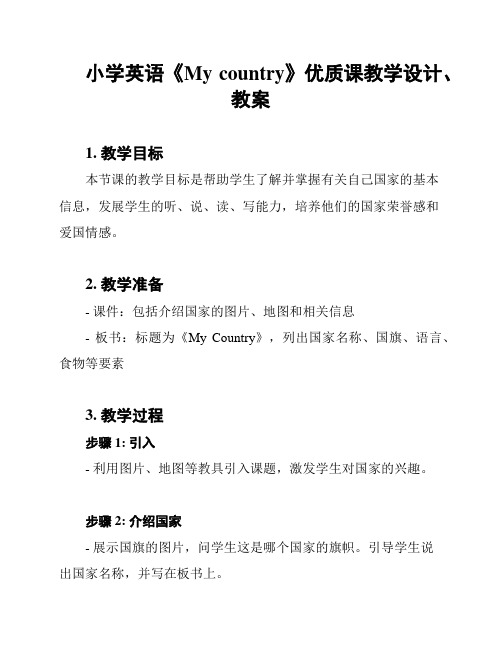
小学英语《My country》优质课教学设计、教案1. 教学目标本节课的教学目标是帮助学生了解并掌握有关自己国家的基本信息,发展学生的听、说、读、写能力,培养他们的国家荣誉感和爱国情感。
2. 教学准备- 课件:包括介绍国家的图片、地图和相关信息- 板书:标题为《My Country》,列出国家名称、国旗、语言、食物等要素3. 教学过程步骤1: 引入- 利用图片、地图等教具引入课题,激发学生对国家的兴趣。
步骤2: 介绍国家- 展示国旗的图片,问学生这是哪个国家的旗帜。
引导学生说出国家名称,并写在板书上。
- 展示国家地图,指出国家的位置,并简单介绍国家的特点和地理位置。
步骤3: 研究国家的语言- 展示国家的语言文字,并教授一些简单的用语,如问候语、数字等。
要求学生跟读并模仿。
步骤4: 了解国家的食物- 介绍国家的典型特色食物,如汉堡包、披萨等,并展示相关图片。
让学生尝试说出食物的名称,并了解一些相关的文化背景。
步骤5: 概括国家的特点和文化- 引导学生用简短的词语或句子来概括国家的特点和文化。
鼓励学生用英语表达自己的观点。
步骤6: 温故知新- 复本节课学到的知识点,让学生回答一些相关问题,加深他们对国家的理解和记忆。
4. 教学评估- 在教学过程中观察学生的参与度和理解程度。
- 进行一些简单的口头问答或书面练,如问答、填空等,以评估学生掌握情况。
5. 课后延伸- 布置相关的课后作业,如写一篇关于自己国家的短文或制作一个海报。
- 鼓励学生在家中进一步了解和探索有关国家的信息。
该教学设计和教案旨在帮助学生了解和熟悉自己国家的基本信息,以及培养他们的爱国情感和文化自豪感。
同时,通过听、说、读、写的综合活动,提高学生的英语能力和跨文化交际能力。
- 1、下载文档前请自行甄别文档内容的完整性,平台不提供额外的编辑、内容补充、找答案等附加服务。
- 2、"仅部分预览"的文档,不可在线预览部分如存在完整性等问题,可反馈申请退款(可完整预览的文档不适用该条件!)。
- 3、如文档侵犯您的权益,请联系客服反馈,我们会尽快为您处理(人工客服工作时间:9:00-18:30)。
小学英语教案(一) Asking the WayI.Teaching ContentAsking the WayA: Excuse me, sir. Can you tell me the way to Bihai Hotel, please?B: Sure. You can go there by bus.A: Is it a long way from here?B: No, it'll take you fifteen minutes.A: Which bus can I take?B: You can take a No. 2 bus.A: Where is the bus stop?B: Just go straight. Look, the bus is coming.A: Thank you very much.B: You're welcome.II. Teaching proceduresStep 1. Warming-upT: Nice to meet you. My name is Bright. B-R-I-G-H-T.Shall we sing an English song named "Bingo", and try to change the' word "Bingo" with my name "Bright"?Step 2. PresentationT: I'm new here, when I arrived at the airport, I heard someone said "对不起"(注①),"早晨好"(注②).I really want to know their meanings in English. Could you help me?S: "对不起" is "Excuse me" and "早晨好" is "Good morning".T: Thanks a lot. And now could you tell me something about your city? I want to travel in this city, but I don't know where I should go.S1: Bai Lian Dong Park.S2: Fisher Girl.S3: Jiuzhou Town.T: Good. But I want to find a hotel now.Please do me a favour. Can you tell me the names of some hotels in this city?S1: 2000 Hotel.S2: Yindu Hotel.S3: Bihai Hotel.(The teacher takes notes while the students are speaking.)Step 3. New structures learningT: They all sound very nice. But how can I get there, by bus or by bike?T: And how long will it take me to get there? Maybe fifteen minutes is enough.(The teacher looks at the watch and gives the students a gesture.)1) Draw a stick-figure picture to help the students understand the meaning of the sentence: "It'll take someone some time to do something."2) Write the sentence "It'll take you fifteen minutes. " on the blackboard, and have the students imitate the sentence.3) A guessing game:T: Please look at these pictures and guess "How long will it take me to ...?"T: How long will it take me to have a football match?S1: It'll take you ninety minutes.T: Yes.4) Get the students to listen to the recording of the dialogue, in order to introduce the new sentence: "Just go straight."5) Use the multi-media to help the students understand the meaning of the sentence "Go straight."6) Write the sentence on the blackboard, and have the students imitate the sentence: "Just go straight."Step 4. Practice1) Ask the students to listen to the dialogue once more, then ask them to repeat after the tape, first individually and then in pairs.2) Encourage the students to read their dialogue with their deskmates.Step 5. ConsolidationT: You know I'm from Shanghai. Maybe in the future you'll go to Shanghai, so I've prepared some photographs for you.1) Show the photographs of "Nanjing Road", "Pudong New Area" and "the Bund" to the students.2) Get the students to ask the teachers from Shanghai something they don't know, such as directions, transportations in Shanghai.3) Ask some students to introduce their tour plans to Shanghai.注①、注②:因竞赛在珠海举行,授课教师用广东话说“对不起”和“早晨好”。
专家点评上海参赛选手祁承辉老师所做的课Asking the Way 是一节理念正确、设计巧妙、活动丰富、效果突出的优秀参赛课。
这堂课充分体现了以学生为主体的教学思想。
本节课主要体现出以下几个特点:1、趋向真实交际的教学设计教师以自己来自上海和对珠海不熟悉为由,请学生向他介绍当地的名胜,进而表示对这些地方很感兴趣,并询问去这些地方的方式和所需要的时间。
由此自然而巧妙地展开本课的话题,使课堂教学从一开始就进入真实的交际场景,形成活跃的课堂气氛。
学生为能够运用自己熟悉的内容与教师交流而获得成功感,并为能通过交流帮助了教师而感到兴奋,从而使学习的自信心倍增。
同时也使课文对话变成实际交流中的表达和交流需求。
在接下来的教学中,教师抓住师生之间的信息差,让学生问有关上海的情况。
学生在教师的引导下(教师询问问题),既进行了存在信息差的实际交流,又练习和掌握了问路与指路的语言结构和用法。
2、以学生为主体的活动安排在本课中,该教师安排了多样的学生活动,其中有个人、两人、小组和全班性的,有教师指导性的,也有需学生独立或合作完成的。
活动均有明确的目标与要求,并能够安排在一定的语境和情景中进行,突出了培养学生用英语做事情和用英语进行交流的能力,体现了交际语言教学的思想。
评价一节课成功与否,主要应看学生在活动中的参与程度(外显的语言行为和内部语言思维过程),学生言语交际的有效性,以及学生在学习中表现出的情感、合作精神和学习与交际策略等方面的发展情况。
在本次课上,学生能够积极参与讨论且活动量大,并有自由发挥的空间,教学效果良好。
教师在教学活动中,注意了自己角色的转换与控制,在启发与示范后,能够把足够的时间留给学生,让学生努力实践与展示自己。
另外,这节课的活动安排张弛有度,活而不乱;同时,教师能根据学生的接受能力和表现状况适时调整活动安排与教学要求,表现了该教师较强的教学能力和教学组织能力,体现了以学生为主体、教师为指导的教学原则。
3.良好的自身素质与教学素质授课教师在教学中表现出较高的教学素养。
首先是良好的教学语言表达能力,语音、语调自然,清晰,强调适度(包括有时降低音量等手段的运用);其次是形体语言在教学中运用相当出色,能够吸引学生的注意力,辅助教学效果突出;还有一个特点是学生思维活跃,课堂教学容量较大;教学节奏掌握得当。
这些都离不开教师自身较高的素质和平时的努力与积累,因为教师的每一节课都是自己整体水平的综合展现。
全国小学大面积开设英语课即将开始,这既给我们带来了机遇,也向我们提出了更高的要求和挑战,希望有更多的优秀小学英语教师脱颖而出。
评课人:张连仲(大赛评委、北京首都师范大学外语系)。
